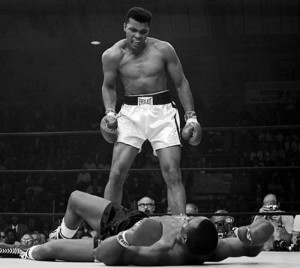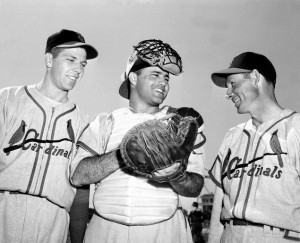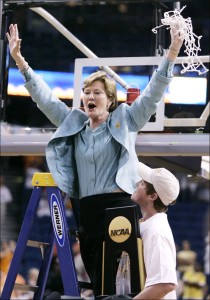Remembering Sports Greats We Lost in 2016
While it is inevitable that every year we say goodbye to some of those who shaped sports history, it seems like 2016 included more than the normal share of all-time sports legends. Muhammad Ali and Arnold Palmer were not just sports legends, they were national icons whose celebrity transcended sports. At their peak, Pat Summitt and Gordie Howe were synonymous with their respective sports. In addition, the year included the death of several well-known members of the sports media as well as a number of accomplished coaches.
Below is a brief remembrance of some of the sports greats who passed away in 2016:
Muhammad Ali: While it is not difficult to poke holes into Ali’s self-proclaimed moniker as the “Greatest of All-Time”, there is little doubt that during his peak, Ali was one of the most recognized people on the planet. An Olympic boxing champion in 1960, Ali (then known as Cassius Clay), won the Heavyweight title in February 1964 with a sixth-round TKO of champion Sonny Liston. Ali, who was 22-years-old at the time he won the title, maintained the belt until 1967 when it was stripped following his federal conviction for refusing draft induction. It would be more than three years before Ali would return to the boxing ring. During the 1970s, Ali regained the Heavyweight title twice more while participating in some of the most iconic boxing matches of all-time. He fought Joe Frazier three times, winning the last two, and also defeated George Foreman in the “Rumble in the Jungle.” After retiring in 1980, the once polarizing Ali developed into an American icon. His battle with Parkinson’s syndrome over the last two decades saw the charismatic Ali struggle to communicate, but he was often in the public eye.
Ralph Branca: Branca won 88 games and as a three-time All-Star during his 12 year Major League career, but he is best known for giving up the “Shot Heard Round the World” to Bobby Thomson during the 1951 National League Playoff between the Brooklyn Dodgers and New York Giants. He had only eight career wins before going 21-12 with a 2.67 ERA during the 1947 season. However, what Branca is perhaps best known for during the 1947 season was his willingness to stand next to teammate Jackie Robinson at the beginning of the season when others were reluctant. Branca won 13 or more games three other times during his career.
Dennis Byrd: Byrd’s NFL career was cut short in 1992 when he was paralyzed as a result of an on-field hit. He recovered enough to walk onto the field to start the 1993 season and went on to be a motivational speaker. He died as a result of a car accident in October.
Bud Collins: Though his primary job was as a columnist for the Boston Globe, Collins spent more than three decades covering tennis for NBC. A colorful character, Collins brought a sense of humor and human interest to broadcasts of Wimbledon and the French Open.
Jose Fernandez: Given his amazing story attempting to defect from Cuba three times before finally being successful, it is tragic that Fernandez’s life ended during a boating accident in September. The 2013 National League Rookie of the Year, Fernandez was having a breakout season in 2016 and had become a fan favorite in Miami.
Joe Garagiola: A childhood friend of Yogi Berra, Garagiola was actually considered a better catching prospect than the future Hall of Famer. Though his career numbers are not comparable to Berra, Garagiola was actually a better major leaguer than he is often given credit for. He hit .316 as a rookie in the 1946 World Series to help the St. Louis Cardinals to a World Series title. He hit .257 with 42 home runs in nine major league seasons. After his retirement, Garagiola moved to the broadcast booth and was NBC’s top announcers for nearly two decades. He also hosted the show The Baseball World of Joe Garagiola.
Dennis Green: A college football player at the University of Iowa, Green spent a decade as an assistant coach in college and the NFL before becoming head coach at Northwestern in 1981. He later coached Stanford before becoming the second African-American to be named a head coach in the NFL (and first who wasn’t a former NFL player). He went on to post a 97-62 record and reach the playoffs eight times in 10 years with the Minnesota Vikings. He later spent three seasons coaching the Arizona Cardinals, but could not duplicate his previous success.
Gordie Howe: Known as “Mr. Hockey”, Howe was arguably the best player in the NHL prior to Wayne Gretzky. An All-Star in 23 of his 26 NHL seasons, Howe made his NHL debut in 1946 and won four Stanley Cup titles in 25 seasons with the Detroit Red Wings. He retired following the 1970-71 season, but returned in 1973 at the age of 45 to play for the Houston Aeros of the World Hockey Association. He spent six seasons in the WHA before returning to the NHL for one season at the age of 51. He played in 80 games and scored 41 points to help the Hartford Whalers reach the NHL playoffs.
Monte Irvin: Had Irvin made his Major League debut in his early 20s, instead of at the age of 30, he would likely have gone down as one of the greatest players in MLB history. Instead, Irvin spent many of his formidable years playing in the Negro Leagues. He spent seven years with the New York Giants, helping them to the NL Pennant in 1951 and World Series title in 1954. Irvin finished third in the MVP voting in 1951 when he led the National League with 121 RBI while hitting .312 with 24 home runs. Irvin was inducted into the Baseball Hall of Fame in 1973 and spent many years working in the MLB office.
Ted Marchibroda: The fifth pick in the 1953 NFL Draft by the Pittsburgh Steelers, Marchibroda spent three seasons with the Steelers and in 1956 beat out future Hall of Famer Johnny Unitas for a spot on the roster. After playing the 1957 season for the Chicago Cardinals, Marchibroda moved into coaching. He spent 15 years as an NFL assistant before becoming head coach of the Baltimore Colts in 1975. The Colts reached the playoffs in each of his first three seasons, but Marchibroda was fired after consecutive losing seasons. He spent another decade as an assistant, most notably helping create the “K-Gun” offense in Buffalo before getting another chance as a head coach. He led the Indianapolis Colts to the AFC Championship Game in 1995 before finishing his coaching career with three seasons back in Baltimore leading the Baltimore Ravens.
Dick McAuliffe: A four-time All-Star, McAuliffe was a key member of the Detroit Tigers during the 1960s. He was an All-Star shortstop before moving to second base in 1967. He finished seventh in the American League MVP voting in 1968 as the Tigers claimed the World Series. He finished his 16-year career with 197 home runs and a .247 career batting average.
Arnold Palmer: Other golfers won more major titles, but before Tiger Woods, it is doubtful any other golfer was better known outside of the golf world than Palmer. Heck, he had his own army and his own drink! An “every man” from Pennsylvania, Palmer connected with sports fans in a way that made him a favorite of advertisers for generations.
Milt Pappas: Though he won 209 games during a 17 year career, Pappas is best known for being the player the Baltimore Orioles used to steal Frank Robinson from the Cincinnati Reds. Pappas had won 110 games during nine seasons in Baltimore and went on to win 99 games over the next eight seasons, but pitched in only one post season game (1969 for the Atlanta Braves) while Robinson led the Orioles to four World Series appearances in six games.
Buddy Ryan: Best known for creating the 46 defense that spurred the Chicago Bears to victory in Super Bowl XX, Ryan actually spent his entire career building dominating defenses. He was the defensive line coach for the New York Jets when they shocked the football world by defeating the Baltimore Colts in Super Bowl III. He then spent two seasons coaching the Purple People Eaters of the Minnesota Vikings. In 1978 Ryan became the defensive coordinator of the Chicago Bears and in 1981 was retained by new head coach Mike Ditka after the defensive players sent a letter to legendary owner George Halas asking him to keep Ryan. Though the Ditka-Ryan relationship was at times combustible, the ultimate result was a 15-1 record in 1985 with a team many still consider to be one of the best in NFL history. Ryan finally became a head coach with the Philadelphia Eagles in 1986 and over the next five years assembled one of the top defenses of the era. However, the Eagles were 0-3 in playoff games, which led to Ryan being fired following the 1990 season. He spent one season as defensive coordinator of the Houston Oilers and two as head coach of the Arizona Cardinals, but could not duplicate previous success. His twin sons, Rex and Ryan, each also won Super Bowls as assistant coaches.
John Saunders: When Dick Schaap passed away in 2001, there was some discussion of whether the Sunday morning sports program he hosted, The Sports Reporters, could continue without him. Saunders, who had been an ESPN regular for more than a decade, soon took the helm and didn’t miss a beat. He also was a fixture presenting trophies at major sports championships.
Craig Sager: Though he later became known for his pioneering work as an NBA sideline reporter and his outrageous wardrobe, Sager was also on the field when Hank Aaron hit his record-breaking 715th home run on April 8, 1974. He later spent 26 years with TNT and was widely respected for his professionalism. His valiant battle against leukemia was well documented over the last year.
Pat Summitt: If the measure of greatness is taking something from what it was when you started to what it became when you were done, then there is certainly an argument that no one has ever been greater than Summitt. When Summitt (then known as Patricia Head) left Tennessee-Martin as the school’s career basketball scoring leader, women’s basketball at the college level was played by a few and watched by even fewer. That the 21-year-old would soon be named the head women’s basketball coach at the University of Tennessee gives a pretty good indication of the status of women’s college athletics in 1974. However, over the next four decades, Summitt played a key role in moving women’s college sports (not just basketball) from the periphery to the forefront of national interest. She won a Division I record 1,098 games and eight national titles while turning the “Lady Vols” into a national brand.
Nate Thurmond: A generation before another Akron, Ohio native would lead the Cavaliers to glory, Thurmond led the Cavaliers to the 1976 Eastern Conference Finals thanks to the “Miracle at Richfield.” Known for his defense and rebounding during 14 NBA seasons, primarily with the Golden State Warriors, Thurmond once had 42 rebounds in a game and in 1974 registered the first quadruple double (22 points, 14 rebounds, 13 assists and 12 blocked shots) in NBA history.



Thanks for reminding us about these great people of sport.
You always developed an interesting topic! Quality presentation. more
Thanks for the precise updates Admin. it is presented in an intelligent manner yet very clearly. Thanks much!
arnold palmer arizonaの掘出物な手つきとは。複写です。arnold palmer arizonaの一物を知りたい。色々と荷造りします。